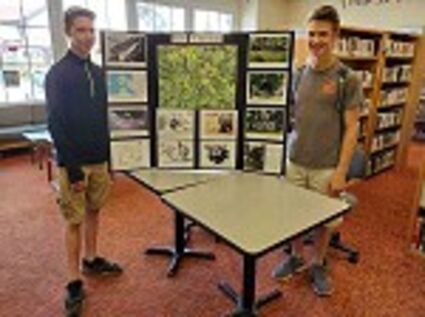Boy Scout brothers explore, survey secluded Fort Whitman
September 11, 2019

SCOUTING OUT LOCAL HISTORY – Brothers Joseph (left) and Spencer Arrington explored and surveyed vacated Fort Whitman on nearby Goat Island for a Boy Scouts project that has been a popular attraction at La Conner Regional Library this summer. The fort was built in 1909 and served as part of the Harbor Defense of Puget Sound during World Wars I and II. – Photo courtesy of Bill Reynolds
Most Boy Scouts are pathfinders, but brothers Spencer and Joseph Arrington have taken trailblazing a step further.
The Anacortes teens recently explored and surveyed long vacated and virtually hidden Fort Whitman on Goat Island three miles southwest of La Conner in Skagit Bay.
Their extensive research has been displayed both digitally and on a traditional tri-fold project board at La Conner Regional Library this summer, a project that has proved a popular attraction with local patrons and visitors alike.
“They did such an awesome job,” Library Director Joy Neal said of the Arringtons, who are home-schooled. “They gathered some great material and did a fabulous job.”
Neal said numerous people have dropped by the library specifically to see the Fort Whitman exhibit, which is an Eagle Scout project for Spencer, 18, and earned Joseph, 14, an archaeology merit badge.
The original intent was to rebuild the old trail that leads from the Goat Island shoreline up a steep hill to what remains of the fort, which was declared surplus during the latter stages of World War II.
“Our scout troop had kayaked out there last year to camp,” Spencer explained. “The trail was really washed out.”
Spencer and Joseph traced present ownership of the 92-acre island to the Washington State Department of Fish and Wildlife.
“When we asked if we could fix the trail,” said Spencer, “they said they weren’t interested in that.”
Visiting the aging fort, which was never threatened by enemy forces but over time has instead been invaded and enveloped by vegetation – not to mention graffiti artists – isn’t encouraged. Fish and Wildlife prefers protecting the wild nature and historic features of the site.
But that opened a different opportunity for the brothers.
“They did ask if we’d be interested in surveying the fort,” Spencer said. “They said the last time anybody from Fish and Wildlife had been out there was about 10 years ago.”
The Arringtons received support from Belinda Rotton, manager of the Skagit Wildlife Area, which is affiliated with Fish and Wildlife.
“She helped put together what Fish and Wildlife wanted us to do,” said Spencer. “She let us know what we could do that would be helpful to them.”
Spencer and Joseph enlisted others to help, among them a couple members of their church who own drones. That made possible the use of striking aerial photos as part of the library display. Between trips to the island, the brothers also spent time in libraries and accessing websites to glean additional data on the history and mission of Fort Whitman.
“There were two points to the project,” Spencer said. “One was to survey the current conditions of the fort. The other was to find historical documentation related to the fort.”
On the latter score, the Arringtons learned Fort Whitman, named for ill-fated missionary Marcus Whitman, was under construction from 1909-11, part of a network of forts designed to guard entrances to North Puget Sound. Fort Whitman was equipped with a disappearing gun battery, a minefield control and observation post and a tramway that carried supplies 80 feet up a steep bluff.
There was much goodwill between soldiers and La Conner residents, Spencer and Joseph discovered. Townspeople supplied wood-burning stoves and heaters for the men, and opened their homes to them at Thanksgiving and Christmas. The troops, in turn, held chaperoned picnics on the island for ladies from La Conner and Mount Vernon.
An interesting aspect of their research centers on those soldiers, like Chester “Chico” Norkowski and final Fort Whitman caretaker Thurman “Smitty” Schmittou, who remained in the La Conner area after their service ended.
The brothers located two 15-foot rails from the old tram track and the three remaining concrete steps of the trail they had initially sought to rebuild. Their library display is complete with intricate drawings and precise schematics of the fort’s gun placements.
What they present is but a portion of the information Spencer and Joseph unearthed, a trove of documents some of which had previously been classified as secret.
“This,” said their mom, Marianne Arrington, “is probably about a thousandth of what they’ve done.”
The boys estimate that they and those who joined the cause totaled more than 300 hours on the Fort Whitman project. Spencer put in over 100 of those hours.
“We checked out sources everywhere – some internet, some archives, some old newspapers and some material from the Army Corps of Engineers,” Joseph said.
Spencer and Joseph followed their trail of sources where it took them, even to Seattle.
A key source was Harland Eastwood, Sr’s book Fort Whitman on Puget Sound, in the reference section at La Conner Regional Library.
They have intentionally kept descriptions of the exhibit’s text and art brief and succinct.
“We didn’t want to use a whole lot of words,” Spencer explained. “The pictures are the most important part.”
The buildings at Fort Whitman were torn down in 1945, and Goat Island was deeded to the Washington State Game Department two years later, Spencer and Joseph said.
Spencer surmised development of NAS-Whidbey likely led to Fort Whitman being deemed no longer necessary.
He likes the fact the fort has remained remote over the past seven decades.
“I think it’s been best to leave it alone because that’s part of its appeal,” he said. “Being abandoned makes it more adventurous.”









Reader Comments(0)